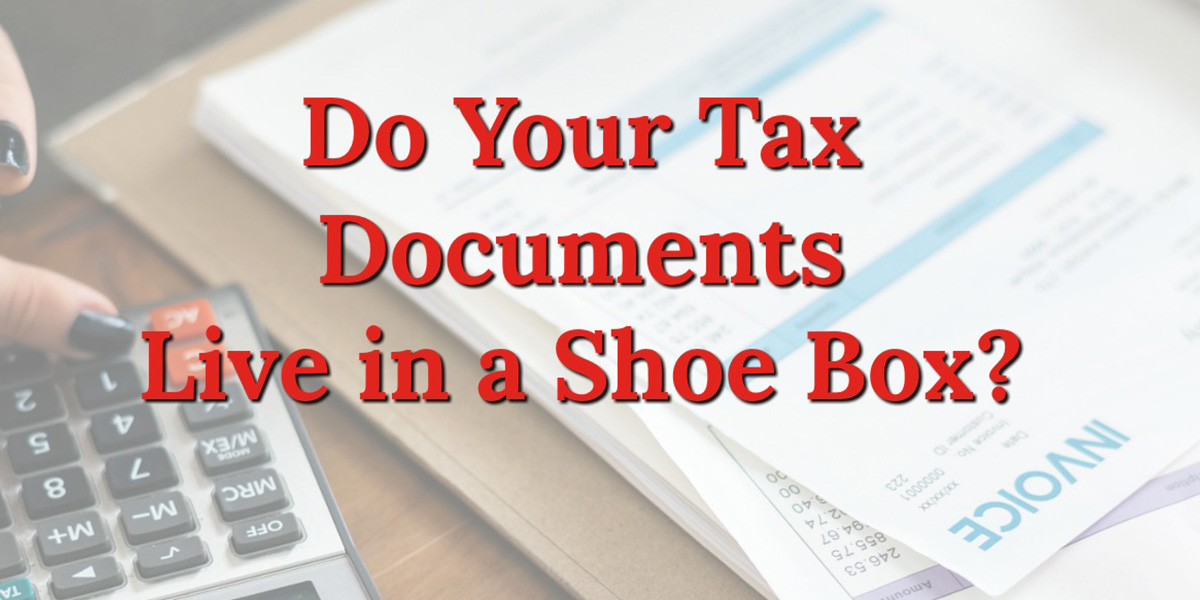
Do Your Tax Documents Live in a Shoe Box?
Some of my clients put all of their tax stuff in boxes and bags (you are not alone by any means).
So when the time comes to give their accountant their tax information, what do they do? Well, as you may have guessed, I have heard it all:
- Pull all-nighters sorting paper
- Sending the box of receipts to their accountant (your accountant hates this)
- Getting extensions (which most of the time says, Hey I’m late, can’t get it together, AUDIT ME)
- Or the famous, I just made up my numbers (yep, people do this)
What I have found in my seventeen years as an organizing consultant, is that:
- People who live this way are entitled to more write-offs than they are getting
- People that do this are stressed and spending much more time than necessary getting their tax paperwork together
One of my clients who operates this way was audited, and while getting all of her paperwork together I found that her deductions were much higher than what she reported to her accountant. The good news is that the audit went smoothly; the bad news is that she was missing a lot of deductions for many years, and therefore paying higher taxes than she should have been.
So…what to do?
I am going to share the basic system that I have been using for my clients with great success. You can do this now for 2019 or to start fresh for 2020.
Create files:
The first file should be a current-year tax file. You may not be putting anything into it until the end of the year, but as you make contributions or pay real estate taxes those documents can go in this file.
The second file is for income. You will put any receipts that you get for income in addition to your 1099s, and W-2s.
The third is a set of files for each credit card, checking account, and any money market and brokerage statements with a checking account attached to it.
The fourth set of files is based on your what your tax deductions are. Make a file for each of those categories. As you get receipts for these items throw them into the appropriate file like medical, education, or unreimbursed business expenses. If you do this throughout the year this will be a breeze for the following year’s taxes.
I recommend that my clients not keep receipts for everything that is consumable: Groceries, lattes, gas, cosmetics, salons, dry cleaners, hardware store, and entertainment to name a few of the more common ones.
Exceptions to this would be receipts for anything you are able to deduct, for high-value items, and for receipts that contain an item that you are going to return.
At the end of every year, you can either remove everything from your files and clip them together or create new files for the next year. Remember that the maximum time you need to keep tax supporting documentation for the IRS is 7 years unless you are committing fraud (can’t help you here).
I will put everything from a year together in one file, box, or bin and at the end of the seven years, the whole file box or bin can be shredded. I do personally pull out some documents and receipts that I want to hold onto longer.
I recommend that you speak to your accountant about what they want you to keep. Mine requires me to keep original receipts, but some allow you to use scanned receipts. The IRS website has information on all of this as well. My choice is to go with the strictest version so that if I am ever audited, my life will be easier.
A helpful resource that we share with our clients is a document retention guideline. This can be a helpful tool when trying to decide what you need to keep and for how long and of course, when in doubt, call your tax professional.
Originally published in the Radnor Patch in March 2011 and has been since updated to reflect current practices and dates.
